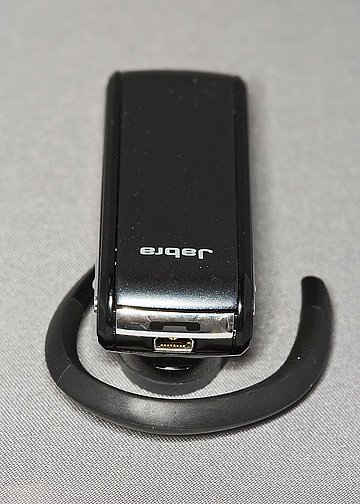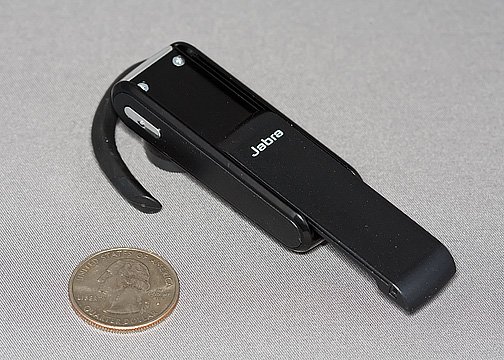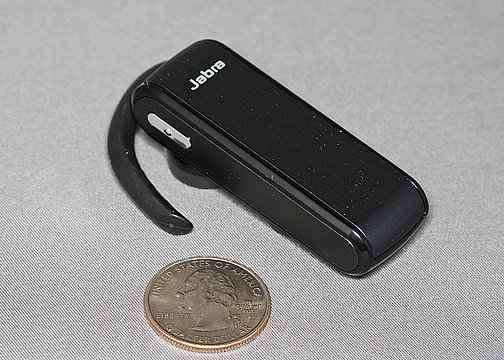Review: Jabra BT5010 Bluetooth Headset

Jabra offers Bluetooth headsets of all sizes, shapes and colors. One of their more unique headsets has to be the Jabra BT5010 ($39.95). Out of the box, this headset doesn’t look much different than most average sized headsets.
It’s when you slide the microphone boom out, dramatically increasing he size of the headset, that it sets itself apart from other headsets. While uniquely designed, the performance of this headset may be equally unique.
Read on for our full review!
Initial impression
The BT5010 comes packaged with a wall charger, USB charging cable (allows you to charge the headset from your computer) and operators manual. Measuring 2.4 inches long, .86 inches wide and .51 inches thick, the BT5010 hits the scales at just over 7 ounces. Extending the slider adds another inch to the headsets overall length.

The BT5010 is held into place by a swivel ear hook that can be shaped comfortably to your ear. The ear hook can be twisted around to accommodate left ear carry as well. Despite its larger size, it does ride fairly comfortable. You won’t forget you’re wearing it but the BT8040 was not as cumbersome as I had thought.
The surface of the headset is a tacky, rubber material. While it helps you grip and slide the boom microphone it also attracts every speck of lint in a three mile area. It’s nothing a warm moist rag won’t take care of but I’m a little concerned that the dust might eventually interfere with the headsets performance.
Asides from the slider, the headset has three primary controls; an answer/end button at the top of the headset and two volume control keys located on either side of the headset. The small on/off button is located on the bottom of the headset (side facing your cheek).
All the latest news, reviews, and guides for Windows and Xbox diehards.

The BT5010 also has an LED embedded in the microphone boom to confirm headset functions or alert users. The headset has a modest assortment of call features including last number redial, reject calls, voice dialing, microphone mute, call waiting and call hold. Some of these features, such as voice dialing, are dependant on the phones features and may not be available. The user manual does a good job of covering what each LED color and flash pattern means as well as the various taps, presses and holds that are required for these features.
Performance

Unlike other headsets, the BT5010 does not enter into pairing mode when first turned on. Users are required to put the headset into pairing mode by, starting with the unit off, pressing the on/off switch until the LED is a constant blue. Don’t confuse the rapid flashing blue LED for pairing mode. If you see this flashing blue, it means the unit is powering off. It took me considerable time to get the headset into pairing mode. Because of the small button, apparently I wasn’t holding it down far enough and kept turning the headset on and then off.
The BT5010 can be connected/paired with two phones at the same time which is an advantage for those who carry a personal and work phone. Jabra doesn’t list the number of device pairing the headset can store in memory so I will assume only two pairings can be stored at once.

Calls can be answered by either pressing the answer/end button at the top of the unit or by extending the boom microphone. The microphone boom has to be extended to talk. The unit also has a vibrate alert for incoming calls which is nice for pocket carry but a little annoying when you have the device on your ear. Fortunately, for those who find this uncomfortable, the vibration feature can be turned off.
Beep!
Call volume is good but there is an annoying beep that sounds every few seconds during a call. At first I thought it was a call waiting alert but when I checked my phone that was not the case. It reminded me of the beep that sounds when you call 911 to let you know the call is being recorded.
I’ve read the user’s manual and searched Jabra’s website about this beep but could not find any information. Jabra does recommend that the headset be worn on the same side of the body as your mobile phone to remove any objects between the headset and the phone. Jabra notes that the unit has an operating range of 33 feet and the signal can be obstructed by major objects. Personally, I don’t see your abdomen as being a major object.
Thinking the beep was an indication of a weak Bluetooth connection and taking Jabra’s recommendation into account, I placed the phone on my right hip and the beep was still present. I went so far as to hold the phone up to the headset and the beep was still present. I can only guess that the beep is verification that the headset is still connected with the phone.
[Editor's Note: I too experienced this beep and I too thought that it was some sort of error or bug on either my part or my phone's part. Bottom line, though, appears to be that the BT8010 emits an annoying beep when paired with Windows Mobile devices.]
Mic Boom

The key feature of this headset is the extending microphone boom. The design is intended to help reduce background noise for optimal voice transmission. While the microphone picked up my voice clearly, it also picked up background noise from the car radio, traffic, etc. as well. Not enough to overshadow my voice but enough to be noticeable and a little distracting.
At first I thought you could use the device with the microphone boom retracted. Some may not like the extra length and prefer to not to extend the boom. With the BT5010, this is not possible. In order to use the microphone, you have to extend the boom.
I do like that the volume buttons are on the sides of the device. They seemed easier to access on the BT5010 than on devices that have them on the top side of the headset. The answer/end button sits high on the device and is a little awkward to manipulate. This button is utilized to reject a call, redial the last number, initiate voice dialing and use the call waiting/hold features. Because of the length of the slider, I don’t know if it could have been moved forward to provide better access.
Conclusion
When I first opened the BT5010 I thought the device’s size would be the hardest thing to get used to. I was concerned that with the microphone boom extended, the headset’s size would be off-balanced and uncomfortable. I was surprised to find out that the headset’s performance took such a strong back seat to its design.
The headset was difficult to pair with my phone, the microphone noticeably picked up background noises, and there was an annoying beep present during calls. On the plus side, the headset was comfortable to wear and did have good call volume (in between beeps). I wasn’t a big fan of the vibrating alert while I wore the headset but it was handy when I was carrying it in my pocket to help alert me incoming calls.
Can it be better? Yes.
The power control could have been tied into the answer/end call button to at least place all the controls and LED indicator on the same side of the device. Whatever is causing the annoying beep can be removed and have the microphone filter more background noise. Get these things under control and this would be a headset worth considering.
However, as is, I was a disappointed with the performance of this headset and would have to look elsewhere for a Bluetooth headset before settling on the BT5010.
| Ratings (out of 5)Construction: 4Performance: 1 (would be 4 without that beep)Comfort: 4Value: 3Overall: | ProsComfortable WearUnique DesignGood Call VolumeConsDifficult controlsDevice Beeps during callsMicrophone picks up on background noises |

Home to the most invested and passionate Microsoft fans, Windows Central is the next generation destination for news, reviews, advice and buying recommendations on the Windows, PC and Xbox ecosystems, following all products, apps, software, AI advancements, and accessories. We've been around for more than decade, and we take our jobs seriously. Windows Central writers and editors value accuracy and editorial independence in everything we do, never receiving compensation for coverage and never pulling punches.
